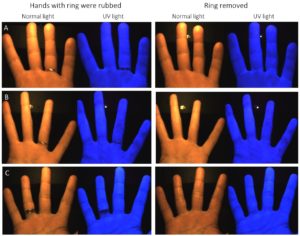In our recent post, we summarized what hand hygiene guidelines suggests about wearing rings, and what scientific evidence exists. As it was shown, results in this field are a bit controversial.
How can it happen that some studies find strong correlation, while others do not? According to our experience, it is a complex problem, and probably influenced by many factors. Rings with stones can accumulate more bacteria [1], and hand hygiene may be performed in a suboptimal way, if wearing rings with sharp edges or stones in it. People naturally avoid those areas when rubbing their skin. Sharp surfaces may also puncture gloves [2], therefore rings should never be used together with gloves. Lose fit and tight fit rings can behave different, and the size of the ring is probably also a significant factor to consider. Figure 1 shows some of our pictures recorded by the Semmelweis Scanner after regular hand rubbing. Sometimes handrub can cover the whole area under the ring (A), sometimes the area under the ring remain untreated (B). In some cases, the area under the ring were covered with handrub, but there were less treated area in the immediate vicinity of the ring (C), that probably was missed due to ring wearing.
Figure 1: Impact of ring wearing on handrub coverage. Source: HandInScan.
It is also described that different hand aseptics can work differently. Wongworawat et al. 2007 (as we mentioned earlier) did not find negative effect of rings when alcohol wash and alcohol-chlorhexidine lotion were used, while applying a povidone-iodine scrub ringed hands had significantly more bacteria. [3]. Another previously mentioned study found that after washing hands with plain soap and water, hands with rings were 1.6 times more likely to be contaminated than hands without rings, while 2.3-fold more likely after use of the alcohol-based hand rub [4].
Is wearing a ring really such a big problem? Result of a self-administrated survey, completed by 147 HCW working on a neonatal intensive care unit was published by Kennedy et al. 2004. While 99% of responders believed that handwashing prevents nosocomial infections, only 35% believed that bacterial counts are higher when rings are worn. 40% believed that rings play a role in nosocomial infections, and 50% that stricter policies concerning e.g. the number of rings would prevent infections. 61% regularly wore at least one ring at work. The study concluded that “HCW did not know the relationship between bacterial hand counts and rings” [5].
CONCLUSION:
Impact of rings on hand hygiene depends on many things, e.g., the type of the ring, the hand antiseptics, and probably many other factors. There are still many open questions in this filed. As we previously concluded, taking off rings during patient care can contribute to improve patient safety.
Read our previous posts on the rings and also the one on the fluorescent trial!
